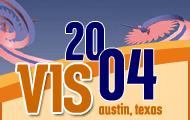 |
| VIS SESSIONS | ||||
| |
Panels Wednesday Panelists:
Theresa-Marie Rhyne (North Carolina State University) Many of us working in visualization have our own list of our top 5 or 10 unresolved problems in visualization. We have assembled a group of panelists to debate and perhaps reach consensus on the top problems in visualization that still need to be explored. We include panelists from both the information and scientific visualization domains. After our presentations, we encourage interaction with the audience to see if we can further formulate and perhaps finalize our list of top unresolved problems in visualization.
Panel 2 Panelists:
David Ebert (Purdue University) Perception is an important topic in scientific visualization. Significant research work remains in understanding the operation of the human vision system. The lessons learned have the potential to drastically reshape visualization tools and techniques. This panel explores the nature of perception and its relevance to our field. Attendees will come away with an appreciation of the complexity of the human vision system and the subsequent difficulty involved in quantifying the benefit of one visualization over another. Additionally, the importance of photorealism versus non-photorealism will be debated. Finally, the art of design, its origin in perception, and its influence on developing effective visual displays will be considered. Thursday
Panel 3 Panelists:
David Ebert (Purdue University) Advances in graphics hardware and rendering methods are shaping the future of visualization. For example, programmable graphics processors are redefining the traditional visualization cycle. In some cases it is now possible to run the computational simulation and associated visualization side-by-side on the same chip. Moreover, global illumination and non-photorealistic effects promise to deliver imagery which enables greater insight into high resolution, multivariate, and higher-dimensional data. The panelists will offer distinct viewpoints on the direction of future graphics hardware and its potential impact on visualization, and on the nature of advanced visualization-related tools and techniques. Presentation of these viewpoints will be followed by audience participation in the form of a question and answer period moderated by the panel organizer. Friday
Panel 4 Panelists:
Mike J. Bailey (Oregon State University) Scientific Visualization has evolved past the point where one undergraduate course can cover all of the necessary topics. So the question becomes "how do we teach scientific visualization to this generation of students?" Some examples of current courses are:
In this panel, we will discuss these types of courses and the advantages and disadvantages of each. We will also explore some issues that you have probably encountered at your university including:
|
|||